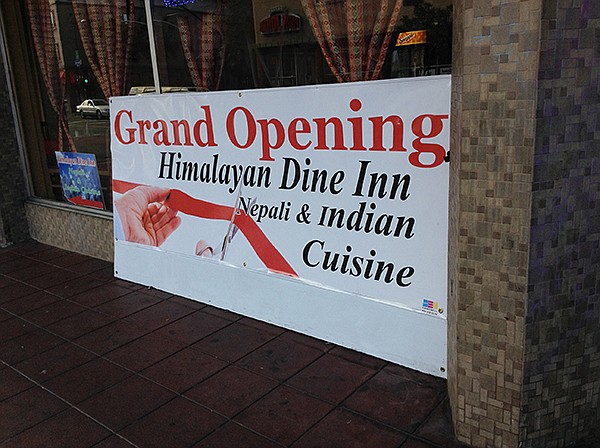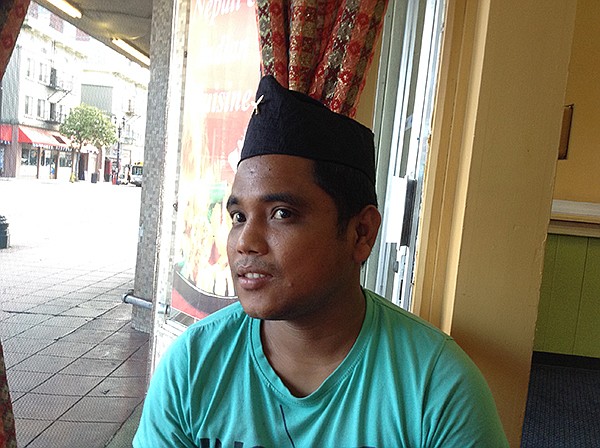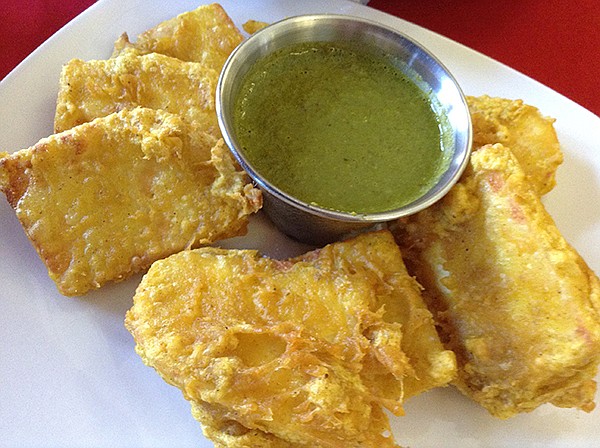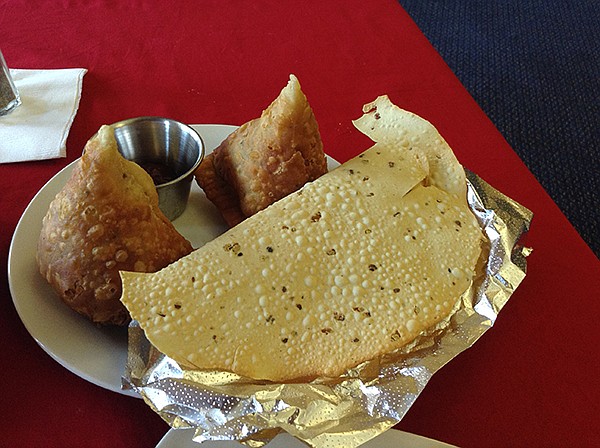 Facebook
Facebook
 X
X
 Instagram
Instagram
 TikTok
TikTok
 Youtube
Youtube


"My name is Bhim. The name means ‘bravery.’”
Bhim’s as tall standing as I am sitting, but he’s stocky, fit-looking, and confident. He’s wearing a Nepalese-style cap, with a little replica of two crossed knives on the front. Oh, right.
Ghurka.
Ghurkas are the famed fighting men of Nepal who have fought with the British Army for the last couple of hundred years.
“Ghurkas? Fierce,” my cousin Bob told me once. He had worked alongside them once when he was in the army, doing field exercises with the Brits. “I was so glad we were on the same side.”
The one thing they always carried was their khukuri, their fighting knife, a scary-looking bent blade halfway between a knife and a scythe.
Bhim points to one hanging on the wall. “We do everything with it, from harvesting to fighting enemies,” he says.
This is happening inside a new place that used to be a Pakistani eatery named “Maizbaan.” It’s called “Himalayan Dine Inn” now, and looks kinda similar. Big old cavern on Broadway.

The “Coming Soon” signs had been up for the longest time, so today, when the sign says “Grand Opening,” I’m in like Flynn. Inside’s been given a lick of paint and fresh red tablecloths, blue carpet, lime-green skirting, cheddar-cheese-gold walls, hanging dish ceiling lights, and red, white, and gold gathered curtains. And your nostrils detect curry in the air. In some ways you feel you’re in some great old Indian hotel.
He hands me a menu. I know it’s going to be mostly like Indian food, with lots of curries, clay-oven-baked breads, and chutneys.
Oh, dang. Too late for their lunch special, basically a chicken or vegetable curry with rice, which goes for $6.95.
Natch, the menu starts off with chicken tikka masala, tandoori chicken breast cooked in a creamy tomato sauce with “Himalayan herbs.”
Aha. Himalayan herbs? I remember hearing about these. It’s what distinguishes Nepalese cooking from Indian cooking. Seems an herb called jimbu is one of the scarce plants that can handle the great heights and the cold of the most fantastic mountains on Earth. It grows all over them, basically holds them together when the snows melt. Tastes like onion and chives, helps sharpen up any dish. Good for you, too, for, like, flu and stomach pains. Also the timur berry. Puts some pepper heat in your mouth.

Whatever. Chicken tikka masala is by far the most popular Indian-style dish for Westerners, Bhim says.
Then there’s the new kid on the block: momo. Basically, Tibetan street food that came over to Nepal with the Tibetan exodus after the Chinese took over. Momos are more Chinese than Indian. Steamed dumplings. Here, a plate of ten chicken momos, stuffed with ground chicken, cabbage, cilantro, and onions and served with chutney, goes for $8.95. They have a vegetarian version for $7.95.
And, yeah, if you’re vegetarian, Indian/Pakistani/Nepalese food is maybe the most interesting food you can get. Because these guys have been into it forever. One of the easiest ones to order is the vegetable biryani, which is basically a mess of flash-cooked veggies mixed into basmati rice, plus raisins and nuts and those Himalayan spices ($8.99).

Bhim says all the chicken dishes come with basmati rice or naan, a flatbread that Gypsies, the Roma, brought from India to the Mediterranean back in the day. So, naan > flatbread > pita > pizza! Does anyone thank the Gypsies for bringing us pizza? All eight chicken curries go for $10.99, including the delicious-sounding coconut chicken curry and chicken vindaloo, the one with potatoes and the onion-sauce gravy.
A whole lot of the same dishes, but with lamb as the meat, go for a couple of bucks more (like, $12.99) and seafood equivalents are $13.95. Good news is most vegetarian dishes, like aloo bhanta (delicious-sounding curry of eggplant and potatoes), go for a couple of dollars less than their meat brothers.

Sigh. I love all this stuff. But soon enough, your eyes start to glaze over. Decisions, decisions. Usually, when in doubt, go for samosas. I ask Bhim for a couple ($4.95). Heck, I also go for a couple of pakoras — fritters of different kinds. I get a paneer pakauda (same as pakora) made of cheese, cabbage, potatoes ($4.95), and a veg pakaud, basically a deep-fried mess of chopped-up onions ($4.95).
First, though, Bhim brings up a bowl of Five Lentil (dahl) Soup with masala (“They are ghana dahl, urad dahl, mung dahl, massor dahl, urad dahl,” says Bhim. They taste good. Basically, you think lentils. And you kind of need the liquid because the dishes, when they arrive, are all deep-fried and sauced up with chutneys.

So, those dishes? The paneer pakauda is the least interesting, a fairly tasteless bunch of yellow cakes that depend on the sauces to give them meaning. But the veg pakaud onions are a lot of fun, especially with the mint sauce they have with them.
But, once again, the samosas win. They’re just tasty and filling enough to make you want more. But even though I’m already full, I sort of wish I’d gone for one of the curries, because they are a whole world of taste in themselves. But, hey, Nepalese Cooking 101. We’ve started the adventure. Next time, the $6.95 lunch special. Then bring 20 of my best friends. Because this food should be a spread for a crowd to share, fight over.
Hopefully not with khukuris.
Prices: Two samosas (stuffed with potato, veggies), $4.95; paneer pakauda (deep-fried cheese, cabbage, potatoes), $4.95; veg pakaud (deep-fried onions, sauce), $4.95; 10 chicken momos (dumplings stuffed with ground chicken, cabbage, onions, with chutney) $8.95; veggie momos, $7.95; vegetable biryani (with basmati rice, raisins, nuts), $8.99; Himalaytan tarkari mixed (tandoori baked chicken breast, lamb cubes, shrimp, veggies in Himalayan sauce) $12.99; lamb vindaloo, $12.99; aloo bhanta (curry of eggplant and potatoes), $9.95
Hours: 10:00 a.m –10:15 p.m. daily (till 11:00 p.m. Friday and Saturday)
Buses: All downtown
Nearest bus stop: Broadway and Ninth
Trolleys: Orange and Blue Lines
Nearest trolley stop: City College



"My name is Bhim. The name means ‘bravery.’”
Bhim’s as tall standing as I am sitting, but he’s stocky, fit-looking, and confident. He’s wearing a Nepalese-style cap, with a little replica of two crossed knives on the front. Oh, right.
Ghurka.
Ghurkas are the famed fighting men of Nepal who have fought with the British Army for the last couple of hundred years.
“Ghurkas? Fierce,” my cousin Bob told me once. He had worked alongside them once when he was in the army, doing field exercises with the Brits. “I was so glad we were on the same side.”
The one thing they always carried was their khukuri, their fighting knife, a scary-looking bent blade halfway between a knife and a scythe.
Bhim points to one hanging on the wall. “We do everything with it, from harvesting to fighting enemies,” he says.
This is happening inside a new place that used to be a Pakistani eatery named “Maizbaan.” It’s called “Himalayan Dine Inn” now, and looks kinda similar. Big old cavern on Broadway.

The “Coming Soon” signs had been up for the longest time, so today, when the sign says “Grand Opening,” I’m in like Flynn. Inside’s been given a lick of paint and fresh red tablecloths, blue carpet, lime-green skirting, cheddar-cheese-gold walls, hanging dish ceiling lights, and red, white, and gold gathered curtains. And your nostrils detect curry in the air. In some ways you feel you’re in some great old Indian hotel.
He hands me a menu. I know it’s going to be mostly like Indian food, with lots of curries, clay-oven-baked breads, and chutneys.
Oh, dang. Too late for their lunch special, basically a chicken or vegetable curry with rice, which goes for $6.95.
Natch, the menu starts off with chicken tikka masala, tandoori chicken breast cooked in a creamy tomato sauce with “Himalayan herbs.”
Aha. Himalayan herbs? I remember hearing about these. It’s what distinguishes Nepalese cooking from Indian cooking. Seems an herb called jimbu is one of the scarce plants that can handle the great heights and the cold of the most fantastic mountains on Earth. It grows all over them, basically holds them together when the snows melt. Tastes like onion and chives, helps sharpen up any dish. Good for you, too, for, like, flu and stomach pains. Also the timur berry. Puts some pepper heat in your mouth.

Whatever. Chicken tikka masala is by far the most popular Indian-style dish for Westerners, Bhim says.
Then there’s the new kid on the block: momo. Basically, Tibetan street food that came over to Nepal with the Tibetan exodus after the Chinese took over. Momos are more Chinese than Indian. Steamed dumplings. Here, a plate of ten chicken momos, stuffed with ground chicken, cabbage, cilantro, and onions and served with chutney, goes for $8.95. They have a vegetarian version for $7.95.
And, yeah, if you’re vegetarian, Indian/Pakistani/Nepalese food is maybe the most interesting food you can get. Because these guys have been into it forever. One of the easiest ones to order is the vegetable biryani, which is basically a mess of flash-cooked veggies mixed into basmati rice, plus raisins and nuts and those Himalayan spices ($8.99).

Bhim says all the chicken dishes come with basmati rice or naan, a flatbread that Gypsies, the Roma, brought from India to the Mediterranean back in the day. So, naan > flatbread > pita > pizza! Does anyone thank the Gypsies for bringing us pizza? All eight chicken curries go for $10.99, including the delicious-sounding coconut chicken curry and chicken vindaloo, the one with potatoes and the onion-sauce gravy.
A whole lot of the same dishes, but with lamb as the meat, go for a couple of bucks more (like, $12.99) and seafood equivalents are $13.95. Good news is most vegetarian dishes, like aloo bhanta (delicious-sounding curry of eggplant and potatoes), go for a couple of dollars less than their meat brothers.

Sigh. I love all this stuff. But soon enough, your eyes start to glaze over. Decisions, decisions. Usually, when in doubt, go for samosas. I ask Bhim for a couple ($4.95). Heck, I also go for a couple of pakoras — fritters of different kinds. I get a paneer pakauda (same as pakora) made of cheese, cabbage, potatoes ($4.95), and a veg pakaud, basically a deep-fried mess of chopped-up onions ($4.95).
First, though, Bhim brings up a bowl of Five Lentil (dahl) Soup with masala (“They are ghana dahl, urad dahl, mung dahl, massor dahl, urad dahl,” says Bhim. They taste good. Basically, you think lentils. And you kind of need the liquid because the dishes, when they arrive, are all deep-fried and sauced up with chutneys.

So, those dishes? The paneer pakauda is the least interesting, a fairly tasteless bunch of yellow cakes that depend on the sauces to give them meaning. But the veg pakaud onions are a lot of fun, especially with the mint sauce they have with them.
But, once again, the samosas win. They’re just tasty and filling enough to make you want more. But even though I’m already full, I sort of wish I’d gone for one of the curries, because they are a whole world of taste in themselves. But, hey, Nepalese Cooking 101. We’ve started the adventure. Next time, the $6.95 lunch special. Then bring 20 of my best friends. Because this food should be a spread for a crowd to share, fight over.
Hopefully not with khukuris.
Prices: Two samosas (stuffed with potato, veggies), $4.95; paneer pakauda (deep-fried cheese, cabbage, potatoes), $4.95; veg pakaud (deep-fried onions, sauce), $4.95; 10 chicken momos (dumplings stuffed with ground chicken, cabbage, onions, with chutney) $8.95; veggie momos, $7.95; vegetable biryani (with basmati rice, raisins, nuts), $8.99; Himalaytan tarkari mixed (tandoori baked chicken breast, lamb cubes, shrimp, veggies in Himalayan sauce) $12.99; lamb vindaloo, $12.99; aloo bhanta (curry of eggplant and potatoes), $9.95
Hours: 10:00 a.m –10:15 p.m. daily (till 11:00 p.m. Friday and Saturday)
Buses: All downtown
Nearest bus stop: Broadway and Ninth
Trolleys: Orange and Blue Lines
Nearest trolley stop: City College